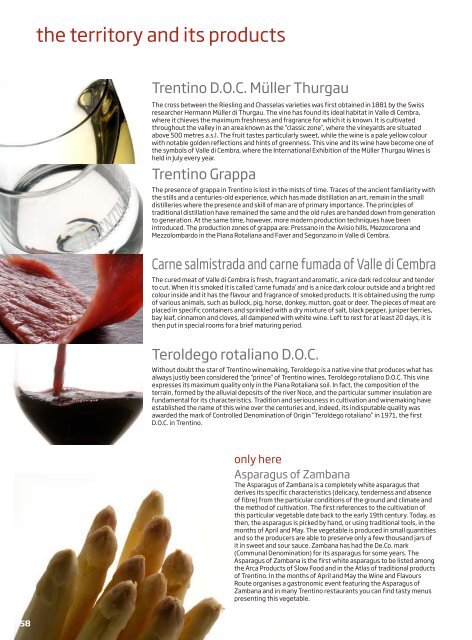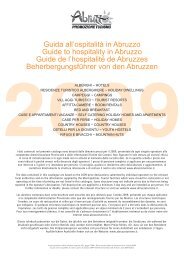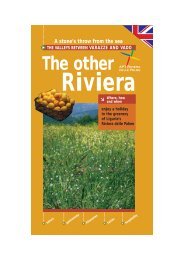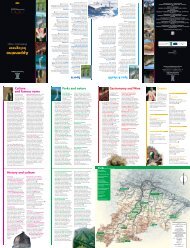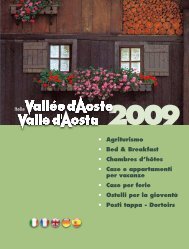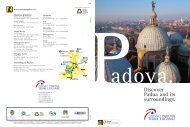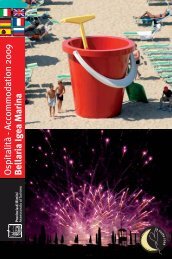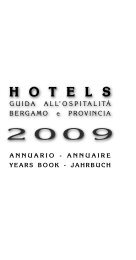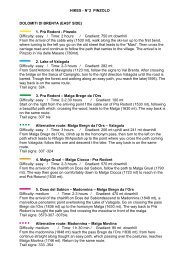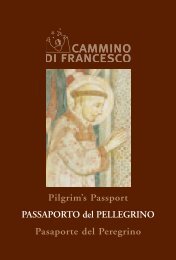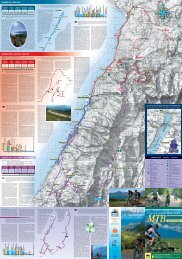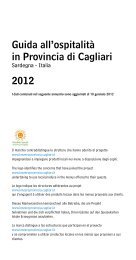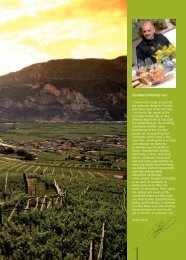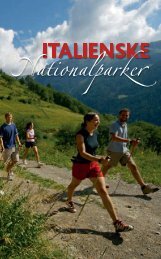ESECUTIVO STRADE VINO E SAPORI inglese.cdr - Trentino
ESECUTIVO STRADE VINO E SAPORI inglese.cdr - Trentino
ESECUTIVO STRADE VINO E SAPORI inglese.cdr - Trentino
Create successful ePaper yourself
Turn your PDF publications into a flip-book with our unique Google optimized e-Paper software.
the territory and its products<br />
<strong>Trentino</strong> D.O.C. Müller Thurgau<br />
The cross between the Riesling and Chasselas varieties was first obtained in 1881 by the Swiss<br />
researcher Hermann Müller di Thurgau. The vine has found its ideal habitat in Valle di Cembra,<br />
where it chieves the maximum freshness and fragrance for which it is known. It is cultivated<br />
throughout the valley in an area known as the “classic zone”, where the vineyards are situated<br />
above 500 metres a.s.l. The fruit tastes particularly sweet, while the wine is a pale yellow colour<br />
with notable golden reflections and hints of greenness. This vine and its wine have become one of<br />
the symbols of Valle di Cembra, where the International Exhibition of the Müller Thurgau Wines is<br />
held in July every year.<br />
<strong>Trentino</strong> Grappa<br />
The presence of grappa in <strong>Trentino</strong> is lost in the mists of time. Traces of the ancient familiarity with<br />
the stills and a centuries-old experience, which has made distillation an art, remain in the small<br />
distilleries where the presence and skill of man are of primary importance. The principles of<br />
traditional distillation have remained the same and the old rules are handed down from generation<br />
to generation. At the same time, however, more modern production techniques have been<br />
introduced. The production zones of grappa are: Pressano in the Avisio hills, Mezzocorona and<br />
Mezzolombardo in the Piana Rotaliana and Faver and Segonzano in Valle di Cembra.<br />
Carne salmistrada and carne fumada of Valle di Cembra<br />
The cured meat of Valle di Cembra is fresh, fragrant and aromatic, a nice dark red colour and tender<br />
to cut. When it is smoked it is called ‘carne fumada’ and is a nice dark colour outside and a bright red<br />
colour inside and it has the flavour and fragrance of smoked products. It is obtained using the rump<br />
of various animals, such as bullock, pig, horse, donkey, mutton, goat or deer. The pieces of meat are<br />
placed in specific containers and sprinkled with a dry mixture of salt, black pepper, juniper berries,<br />
bay leaf, cinnamon and cloves, all dampened with white wine. Left to rest for at least 20 days, it is<br />
then put in special rooms for a brief maturing period.<br />
Teroldego rotaliano D.O.C.<br />
Without doubt the star of <strong>Trentino</strong> winemaking, Teroldego is a native vine that produces what has<br />
always justly been considered the "prince" of <strong>Trentino</strong> wines, Teroldego rotaliano D.O.C. This vine<br />
expresses its maximum quality only in the Piana Rotaliana soil. In fact, the composition of the<br />
terrain, formed by the alluvial deposits of the river Noce, and the particular summer insulation are<br />
fundamental for its characteristics. Tradition and seriousness in cultivation and winemaking have<br />
established the name of this wine over the centuries and, indeed, its indisputable quality was<br />
awarded the mark of Controlled Denomination of Origin “Teroldego rotaliano” in 1971, the first<br />
D.O.C. in <strong>Trentino</strong>.<br />
only here<br />
Asparagus of Zambana<br />
The Asparagus of Zambana is a completely white asparagus that<br />
derives its specific characteristics (delicacy, tenderness and absence<br />
of fibre) from the particular conditions of the ground and climate and<br />
the method of cultivation. The first references to the cultivation of<br />
this particular vegetable date back to the early 19th century. Today, as<br />
then, the asparagus is picked by hand, or using traditional tools, in the<br />
months of April and May. The vegetable is produced in small quantities<br />
and so the producers are able to preserve only a few thousand jars of<br />
it in sweet and sour sauce. Zambana has had the De.Co. mark<br />
(Communal Denomination) for its asparagus for some years. The<br />
Asparagus of Zambana is the first white asparagus to be listed among<br />
the Arca Products of Slow Food and in the Atlas of traditional products<br />
of <strong>Trentino</strong>. In the months of April and May the Wine and Flavours<br />
Route organises a gastronomic event featuring the Asparagus of<br />
Zambana and in many <strong>Trentino</strong> restaurants you can find tasty menus<br />
presenting this vegetable.<br />
58


